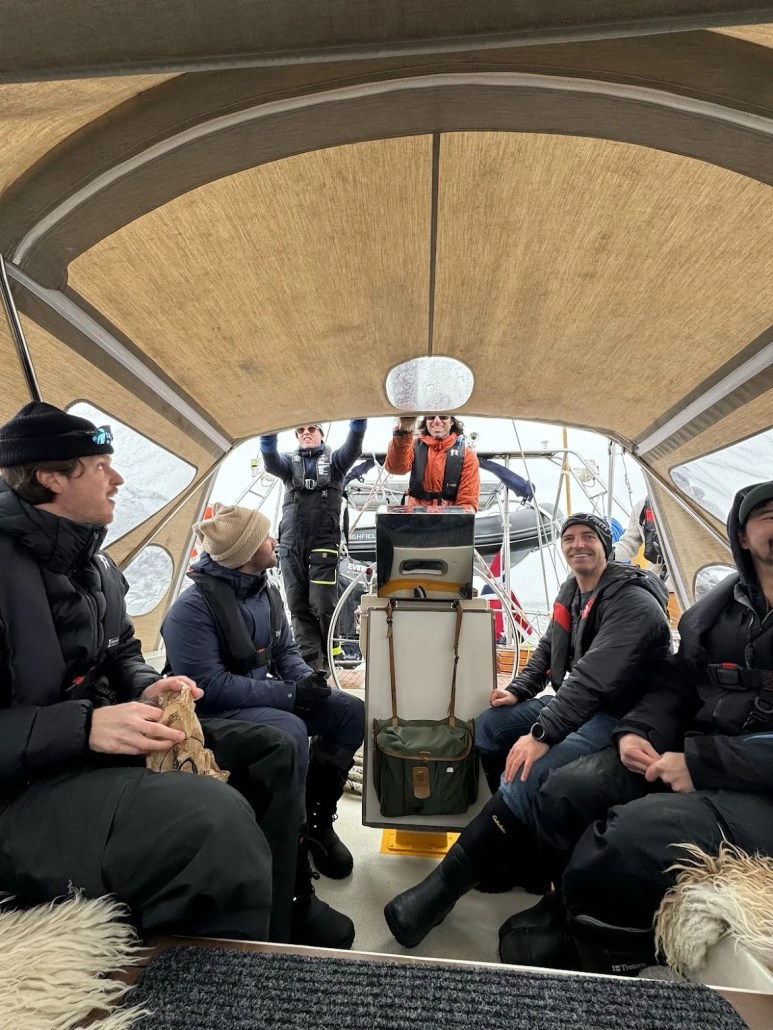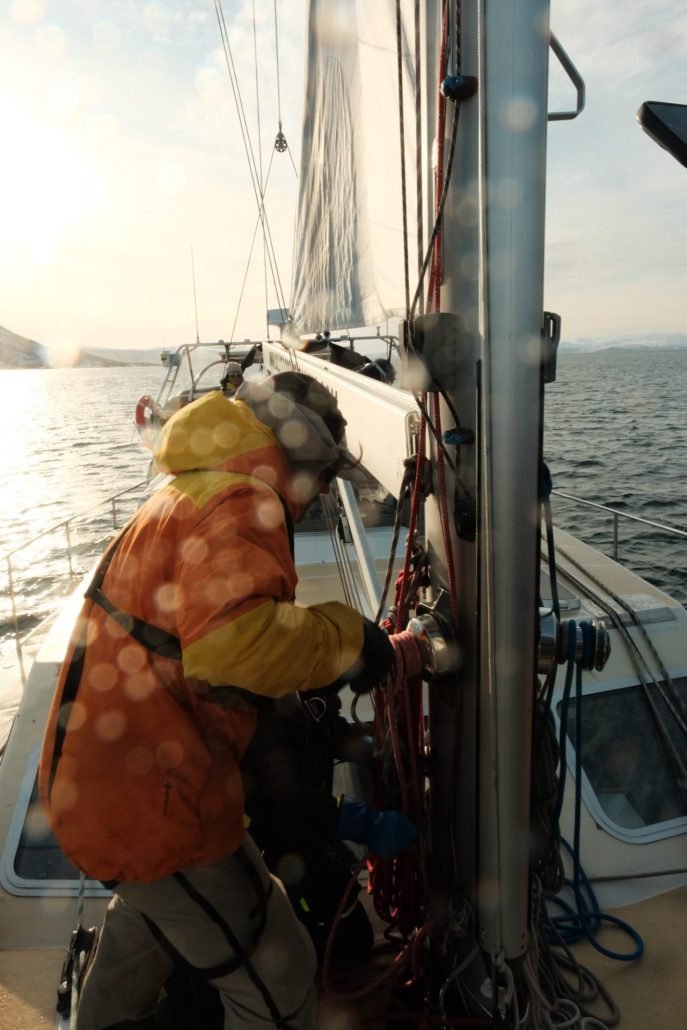Lyngen, Norway Ski and Sail Trip
Photos: Grant Francis

A ski and sail trip through Troms county, but better known as the Lyngen Region of Norway has been on my radar for sometime —the blend of sailing through the arctic fjords and islands in search of ski descents plunging from summit to sea seamed like an incredible adventure. It finally came to fruition April 10-22, 2025.


The Lyngen Alps of Norway sit close to 70 degrees north in the Arctic Circle. While the Lyngen Peninsula has been a hot bed for ski touring for quite some time, the outer islands offer plenty of ski descents away from the busier parts of the Lyngen Region. Most of the islands are accessible by ferry, but using a sail boat allows for flexibility and the opportunity to incorporate sailing as another part of the adventure.


Norway’s maritime heritage is well known and is best experienced by boat in my opinion. Waking up to a gently rocking boat anchored in protected bay or feeling the salt water of the Norwegian Sea spray over the bow while the main sail is stretched tight by the northeast wind harkens back to a different time. One can only imagine what it was like living in one of the villages on these remote islands when fishing and farming was life.



Our trip started in the city of Tromsø, Norway where I met my six clients and Maria and Ulrik, the owners/operators of Jolly Good Times Sailing and got on board their 15m Dutch built sail boat named Jolly. Maria and Ulrik have been operating their business since 2019 and are full-time boat dwellers along with their dog Ramoncito. The experience they offer is different than other businesses who run charted sailing trips, principally because they welcome guests in to the their home aboard Jolly. Their hospitality is unparalleled with Maria’s motherly warmth and Ulrik’s dry sense of humour. Their expertise as sailors is evident too with their ability to read the wind, forecast weather and choose sheltered anchorages.




After a safety briefing and boat orientation, we set sail from Tromsø in the afternoon on the 14th of April and headed northeast up the fjord towards our first ski stop. By mid-April the days are already quite long in the Troms/ Lyngen regions with operable light until 10pm. The daylight gains each day are significant and by the end of your trip on April 22, there was only a few hours of relative darkness in the polar nights. This was perfect for our program as we generally sailed an hour or two each morning and finished the day with a passage to another island.


Over the course of the eight day ski and sail trip we skied on six different islands, one day on the Lyngen Peninsula, summited six mountains, spent five nights at anchor and two nights in harbours with Jolly as our mobile basecamp.

Boat living is tight, but not cramped, and our time spent on Jolly was quite comfortable. Her build was solid, with a steel hull, aluminum deck and warm, dry insulated galley and cabins. There were three bedrooms for the six guests, plus Maria and Ulrik’s cabin, while I slept on the couch in order to give the clients a bit more space. The Jolly also has three bathrooms each equipped with a shower and a 1000l water tank, which makes for a comfortable experience.

Packing light is of the essence as space is limited on a boat. Generally for a week long trip all you need is your ski kit, plenty of underwear and socks, a couple of t-shirts, a set of travel/hang out clothes, a bathing suit and set of tall rubber boots. Wool base layers are particularly well suited to the coastal Norwegian climate. Bring a soft duffel bag and a lightweight ski bag that will pack down and stow well.

Each day started off with a typical Norwegian breakfast with lots of Ulrik’s freshly baked “Captain’s Bread”, brown and other Norwegian cheeses, various types of herring, eggs, juice, plenty of coffee and tea and other sorts of jams and spreads. While the group made their lunches as they sat at the table Maria and Ulrik would do the breakfast dishes. Meanwhile, I would get the skis and splitboards ready to load into the dingy or help Ulrik pull up the anchor.




Arctic Norway has some of the most accessible ski touring in the world. Virtually everywhere you look, there is skiable terrain. Generally speaking, the birch forests offer little in the way of bushwhacking and the lay of the land is quite navigable by ski. With a snow line that starts at sea level and Norway’s Right to respectfully Roam, you can access just about anything that is enticing to ski.

Skiing by boat is a bit more complicated than driving to your local trailhead, but with a systematic approach it is actually quite efficient. The two biggest things are finding a good anchorage in close proximity to your ski objective and a good spot to bring the dingy ashore.



Working with Ulrik closely over the course of trip to integrate our skiing and sailing programs in order to optimize the respective experiences proved to be an enjoyable challenge. Every night we’d sit down and pour over topographical maps, nautical charts and a selection of weather models in order to plan the following day’s program.

With land based skiing, you’d never have to consider how the winds would affect a two hour crossing of a straight between two islands. However when your plans for the next day include an evening sail to the next island, you have to pay close attention to when the winds will pick up and whether they’ll shift direction or not. Furthermore, you can’t drop anchor just anywhere along the way. Anchorages have to be carefully selected according to the winds and the swell. Otherwise you’d spend the night bobbing and swaying in the wind and the waves.

While most of the marketing material you’ll see for ski touring in Norway’s Lyngen Alps will be blue bird powder turns above the sea; the truth is the Norwegian Sea fosters harsh weather and strong winds. We lucked out on this trip and had a bunch of blue skies and smooth sailing. But we also encountered some stormy weather too, with 60 km/h winds, whiteout conditions and some elevated freezing levels.


The stormiest day we encountered was spent on a remote outer island on the edge of the open waters of the Norwegian Sea. Freezing levels were starting to drop and the wind was howling out of the Northeast as we walked up towards a normally mellow 850m summit with a road to the top, however on this day the conditions were savage and we turned around 100m short of the summit after nearly getting blown off our feet. Getting buffeted by those arctic winds coupled with jumping in the dingy with Ulrik to retrieve our fishing net amidst 1 meter waves, lended credence to the tails a local fisherman recounted at a local pub. The environment is beautifully harsh up there and if you’re not careful, it will kill you. This winter alone, five fisherman died and four fishing boats capsized in bad weather.

A couple of nights, before we’d spent the night tied to a pier in a small village on the Lyngen Peninsula, where we enjoyed a sauna and a beer at a local establishment while we filled up our on-board water tank. The freezing levels were forecasted to rise to mountain top and fall a bit over night, so we decided to test the conditions and do a portion of one Lyngen’s classic tours the next day. It was busy and the skiing was marginal, but we did manage to get some decent views while stretching the legs.


One of the highlights of the trip ensued on our passage to the next island that evening. The clients were hanging below deck and I went down to grab some tea and see how they were doing. Out of the port side window, I noticed a dorsal fin rise from the water on the horizon. Before long, there were five white beaked dolphins surfing and jumping around the bow of the boat. They swam along side us for at least a half an hour as they escorted us to a fishing spot; a relatively shallow area in the middle of a deep fjord.


After they swam off, we started to jig for haddock and cod and before long Ulrik and I were gutting and filleting the catch as we finished our passage to the next island. Just before darkness settled in, we set the anchor in a protected bay, while Maria fried up the most amazingly fresh haddock and cod fillets I have ever tasted.


The mid-trip storms were bookended by good weather and great skiing. The first two full days of skiing delivered blue skies, summits and powder all the way to sea level and the last few days of the trip followed suit. Ski touring to the summit of a mountain with 360 degree views of fjords, islands and the open ocean is about as good as it gets. Honestly, I found it hard to pay attention while skiing because the views were so spectacular.









The Norwegian culture is incredibly warm and welcoming. On numerous occasions we ran into Norwegians who were happy to stop and talk to us about their lives, the area and the history. The ski culture there is incredible.

On the last day of the trip, we headed to Tromsdaltinden by bus from Tromsø; it’s a 1200m peak that dominates the horizon southeast of Tromsø. It was about the busiest ski touring experience I have ever encountered, but it was also quite interesting to see how many local people were out skiing. After a lap on the SE side of the mountain, I went back up for a lap on the W face as I wanted to ski back to the outskirts Tromsø via a nordic trail. As I skated down the trail, I relished in notion of of what an incredible trip this had been.




If you’re interested in doing a trip like this in the future, we’ll be heading back again, drop a line for details.


